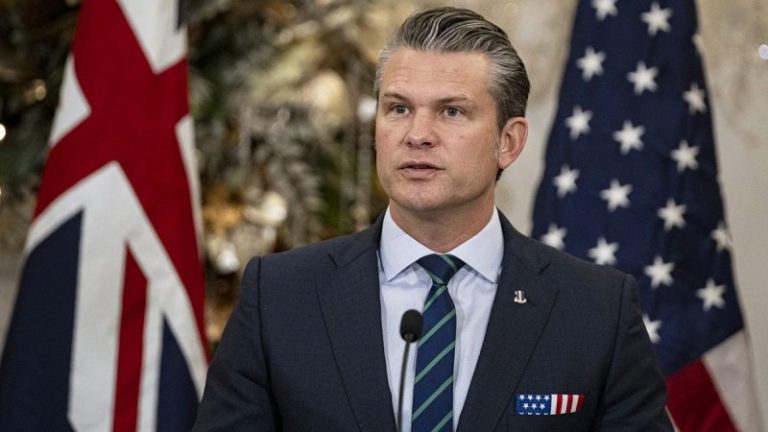A new report released Wednesday from Polaris National Security details what the group says are 100 foreign policy achievements from President Donald Trump’s second term. The document is organized chronologically, starting with his return to office in January and tracking each major foreign policy move through the present day.
The report, titled ‘100 Trump Foreign Policy Wins From 2025 the Media Wants You to Miss,’ is an advocacy and policy analysis document that reflects the authors’ evaluation of U.S. foreign policy developments over the past year.
‘Since January, the Trump administration has moved with historic pace to restore America’s strength and security,’ the report states, arguing that the administration has emphasized deterrence, alliance burden-sharing and direct engagement with adversaries.
Venezuela and Western Hemisphere strategy
The report groups several Venezuela-related actions into what it describes as a broader U.S. policy shift in the Western Hemisphere. It highlights expanded counter-narcotics operations off Venezuela’s coast, including airstrikes on maritime vessels linked to organizations such as Tren de Aragua and the National Liberation Army. The campaign, called Operation Southern Spear, is described as underscoring a commitment to ‘defending the homeland from the influx of fentanyl and other illicit drugs ravaging American communities.’
The administration also raised the U.S. reward for information leading to the arrest of Venezuelan President Nicolás Maduro to $50 million, citing a public announcement from Attorney General Pam Bondi accusing Maduro of central involvement in narcotics trafficking. Venezuela has rejected the allegations. Polaris links these actions to the 2025 National Security Strategy, calling it ‘the most significant hemispheric reorientation of U.S. foreign policy in decades.’
Cale Brown, chair of Polaris National Security and former State Department principal deputy spokesperson, said the administration’s posture marks a reset on the global stage. ‘President Trump has taken the world stage by storm, reasserting American strength after four years of weakness,’ he said.
Gaza ceasefire and hostage releases
A substantial section of the Polaris report focuses on the October Gaza ceasefire, which it calls a central diplomatic breakthrough involving the United States, Israel and Hamas. According to the document, the agreement ‘secured an immediate ceasefire and the return of all surviving hostages,’ including Americans, with one hostage still unaccounted for. It also outlines plans for prisoner exchanges, Gaza’s demilitarization, an international stabilization force, transitional governance and large-scale reconstruction.
The report also highlights a November U.N. Security Council vote in which a U.S.-led Gaza resolution passed 13–0, with Russia and China abstaining. The resolution is described as providing ‘an international legal framework for the next phase of the Israel-Hamas ceasefire.’
Additionally, the administration’s prohibition on U.S. taxpayer funding for UNRWA is noted, citing U.S. concerns over alleged ties between some personnel and Hamas. UNRWA denies institutional involvement in terrorism, while U.S. officials say the move was based on national security considerations.
Iran nuclear strikes
The report cites U.S. military strikes carried out in June against Iranian nuclear facilities using B-2 bombers and bunker-buster munitions, framing the mission as proof that the United States ‘will not tolerate a nuclear-armed Iran.’ Iran denies pursuing a military nuclear program.
Nathan Sales, a distinguished fellow at the Atlantic Council and former State Department counterterrorism coordinator, said the administration views regional diplomacy primarily through the lens of countering Tehran. ‘The Trump administration gets that the Iranian regime is the fundamental source of violence and instability across the Middle East,’ Sales said.
However, some analysts say the administration’s record presents sharp contrasts. Foreign policy analyst and editor-in-chief of the Foreign Desk Lisa Daftari said that while Trump has delivered on several strategic priorities — including strong support for Israel, terrorist redesignations, aggressive action against drug cartels and renewed momentum behind the Abraham Accords — other moves warrant closer scrutiny.
‘This record is tempered by concerning diplomatic overtures that urge caution. The characterization of Syria’s president as ‘young, attractive tough guy’ appears premature given unverified claims about severing ties with terrorist organizations—particularly troubling in light of recent attacks on U.S. servicemen. Similarly, the administration’s approach to Turkey and Saudi Arabia suggests a willingness to extend trust and strategic concessions that may exceed what these relationships warrant, potentially squandering leverage on critical issues like the Abraham Accords. Whether these calculated diplomatic gambles yield strategic gains or prove costly remains an open question. The true measure of this foreign policy doctrine will ultimately depend on how these relationships and decisions unfold in 2026.’
NATO defense spending commitments
The report also points to commitments made at the NATO summit in The Hague, where alliance members pledged to raise defense spending to 5% of GDP by 2035, far above the longstanding 2% benchmark. The document says the pledge followed sustained U.S. pressure for ‘fairer burden-sharing among allied nations.’
Armenia–Azerbaijan peace pledge
The report highlights an August agreement signed at the White House by the leaders of Armenia and Azerbaijan aimed at ending the Nagorno-Karabakh conflict. The declaration includes commitments on border security, regional transit routes and economic cooperation involving the United States.










